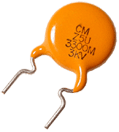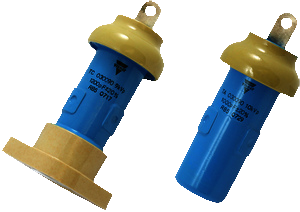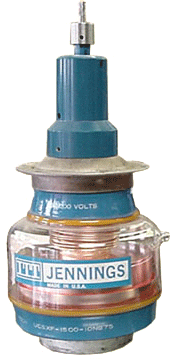High-Power RF Capacitors
Serge Stroobandt, ON4AA
Copyright 2007–2019, licensed under Creative Commons BY-NC-SA
- Home
- Antenna Components
- RF Capacitors
Welcome to the fascinating world of «exotic» RF components! «Exotic» means «difficult to locate», because a typical electronics shop will usually not carry these high-voltage items. Below lists of suppliers are not exhaustive, but will hopefully help you find what you need.
Ceramic disc capacitors
 ceramic disc capacitor
ceramic disc capacitor- Some ceramic disc capacitor are rated up to the kilovolt range. However, RF current handling is limited due to the narrow lead contacts and the skin effect. Some suppliers:
- RF Parts (San Marcos, CA, USA)
- Surplus Sales of Nebraska (Omaha, NE, USA)
- Dan’s Small Parts and Kits (Missoula, MT, USA)
- Kent Electronics (Hoek, Zeeuws-Vlaanderen, Netherlands)
- Dr Alex Gavva, UR4LL, Surplus Parts & Equipment (Kharkiv, Ukraine)
- Amateur radio boot sales, flea markets, fairs & conventions
Air capacitors
 split-stator variable air capacitor
split-stator variable air capacitor- Conventionally-constructed RF air capacitors are not immediately my favourite type of capacitor. Air capacitors collect dust with their open construction. More importantly, air capacitors have a low breakdown voltage. However, one variant of air variable capacitors is unique because of its high current rating. The design of variable split-stator —or «butterfly»— capacitors is such that no RF conduction currents flow through the bearings of the rotor. In low to moderate power applications, air fixed and variable split-stator capacitors can be a viable and budget-friendly alternative to vacuum capacitors. Some suppliers:
- Surplus Sales of Nebraska (Omaha, NE, USA)
- Elektrodump (Emst, Gelderland, Netherlands)
- Dr Alex Gavva, UR4LL, Surplus Parts & Equipment (Kharkiv, Ukraine)
- Amateur radio boot sales, flea markets, fairs & conventions
Door-knob capacitors
 door-knob capacitor
door-knob capacitor- Door-knob capacitors are a cheap, robust, reliable and easily mountable alternative to expensive fixed-value vacuum capacitors. Many European surplus doorknob capacitors are Russian made. Picofarad in the Cyrillic alphabet is denoted as
пФ. The Cyrillic letterпmay appear to Westerners as a Latinnof nano, but in reality it is a “pe” of pico. Kilovolt in Cyrillic is written asкВ. Suppliers:
- CeramTec RF barrel capacitors & RF disc capacitors (Germany & worldwide)
- RF Parts (San Marcos, CA, USA)
- HV Stuff (Xi’an, China)
- HVC Capacitor Manufacturing Co.,Ltd (Shenzhen, China)
- Surplus Sales of Nebraska (Omaha, NE, USAA): ceramic type and mica & ceramic type
- Elektrodump (Emst, Gelderland, Netherlands)
- DL9USA (Spremberg, Brandenburg, Germany)
- Dr Alex Gavva, UR4LL, Surplus Parts & Equipment (Kharkiv, Ukraine)
- Your local eBay online auction
- Amateur radio boot sales, flea markets, fairs & conventions
Pot capacitors
 pot capacitors
pot capacitors- RF pot capacitors have a similar field of application as door-knob capacitors. However, on some occassions pot capacitors are a bit more difficult to mount. Suppliers:
- CeramTec RF pot capacitors & RF tubular capacitors (Germany & worldwide)
Vacuum capacitors
 variable vacuum capacitor
variable vacuum capacitor- Manufacturers:
- Jennings Technology (San Jose, CA, USA)
- Omnicor (Meiden) (Foster City, CA, USA)
- Meiden Europe (Tilbrook, Milton Keynes, UK)
- Comet (Flamatt, Bern, Switzerland)
- Meidensha Corporation (Tokyo, Japan)
Suppliers:
- Max-Gain Systems, Inc. (Marietta, GA, USA)
- Elektrodump (Emst, Gelderland, Netherlands)
- DL9USA (Spremberg, Brandenburg, Germany)
- Dr Alex Gavva, UR4LL, Surplus Parts & Equipment (Kharkiv, Ukraine)
- Your local eBay online auction
- Amateur radio boot sales, flea markets, fairs & conventions
Vacuum capacitors can die!
Beware of glass vacuum capacitors that have been badly handled or that have been poorly protected during transit. The glass envelope may have cracked, destroying the vacuum. In capacitors with clear glass envelopes and copper electrodes, air ingress is indicated by slow discolouration of the copper. The voltage rating of an air-filled capacitor at atmospheric pressure (760torr or 1.01bar) is about thirteen times lower than that of an otherwise identical vacuum capacitor (at 10 torr).1
Home-brew RF capacitors
Over the years, many amateur radio magazines have been publishing articles about building transmitting magnetic loop antennas. These antennas appeal by their very compact size, sharp directivity nulls and high signal-to-noise ratio on reception.
The great flaw of these antennas is their very limited radiation impedance. Consequently, the radiating efficiency of these magnetic dipoles is extremely low. —That is, if you are not resorting to super-conducting materials!— Due to the resulting high Q-factor of these antennas, voltages and currents are extremely high. This lead to a number of very interesting ideas about home-brewing high-power RF capacitors being published in articles about magnetic loop antennas.
One idea I successfully employed on VHF, consisted out of a copper fitting, lined with a 1.5mm-thick PTFE (Teflon) sheet, and inserted by a snugly fit brass bolt.
References

This work is licensed under a Creative Commons Attribution‑NonCommercial‑ShareAlike 4.0 International License.
Other licensing available on request.

Unless otherwise stated, all originally authored software on this site is licensed under the terms of GNU GPL version 3.
This static web site has no backend database.
Hence, no personal data is collected and GDPR compliance is met.
Moreover, this domain does not set any first party cookies.
All Google ads shown on this web site are, irrespective of your location,
restricted in data processing to meet compliance with the CCPA and GDPR.
However, Google AdSense may set third party cookies for traffic analysis and
use JavaScript to obtain a unique set of browser data.
Your browser can be configured to block third party cookies.
Furthermore, installing an ad blocker like EFF's Privacy Badger
will block the JavaScript of ads.
Google's ad policies can be found here.
transcoded by
 .
.


